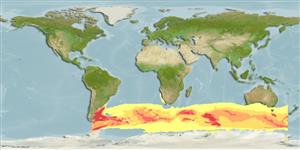Mammalia |
Carnivora |
Otariidae
Environment: milieu / climate zone / пределы глубины / distribution range
экология
батидемерсальный. Temperate; 0°N - 90°S, 78°W - 165°E
Indo-Pacific, Atlantic Ocean and the Antarctic: Antarctic Zone of South Atlantic, Indian and western South Pacific sectors of Southern ocean. Tropical to polar.
Length at first maturity / Size / Weight / Возраст
половая зрелость: Lm ? range ? - ? cm Max length : 200 cm TL самец/пол неопределен; (ссылка 1394); 140 cm TL (female); наибольший вес (опубликованные данные): 230.0 kg (ссылка 1394); наибольший вес (опубликованные данные): 230.0 kg
Prefers rocky habitats; haul out on sandy beaches and move into such vegetation as tussock grass; found out to sea. In winter, males and subadults occur south to the edge of the consolidated pack ice, and can be found haled out on sea ice. Feeds on krill and fish. They prefer rocky habitats; haul out on sandy beaches and move into such vegetation as tussock grass; found out to sea; In winter, males and subadults occur south to the edge of the consolidated pack ice, and can be found haled out on sea ice. Feeds on krill and fish (Ref. 1394).
Life cycle and mating behavior
половая зрелость | размножение | нерест | Eggs | Fecundity | Larvae
Основная ссылка
ссылки | координатор | соавторы
Jefferson, T.A., S. Leatherwood and M.A. Webber 1993 FAO species Identification Guide: Marine Mammals of the World. Rome, FAO. 320 p. + 587 figures. (ссылка 1394)
Статус Красного Списка МСОП
(ссылка 130435: Version 2025-1)
Статус СИТЕС (ссылка 108899)
CMS (ссылка 116361)
Not Evaluated
Угроза для людей
Использование человеком
рыболовство: коммерческий
FAO - рыболовство: Видовой профиль | FishSource | Sea Around Us
инструменты
дополнительная информация
Life cycleразмножение
половая зрелость
Fecundity
нерест
Eggs
Развитие икры
Larvae
PhysiologyOxygen consumption
Human RelatedStamps, coins, misc.
ресурсы в Интернет
Estimates based on models
Preferred temperature
(Ref.
115969): -1.1 - 6.3, mean 2 (based on 688 cells).
устойчивость к внешним воздействиям
средний (среднего размера), минимальное время удвоения популяции 1.4-4.4 года (K=0.13-0.44).
Fishing Vulnerability
High to very high vulnerability (72 of 100).
Категория цены
Unknown.
